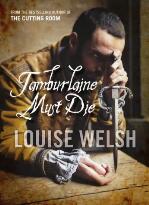Book Review: Louise Welsh's Tamburlaine Must Die
by anna battista
 I doubt there are out there many people who don't have a soft spot for Christopher Marlowe: he always oozed coolness and mystery from the pages of his plays, English anthologies and school textbooks. How was he killed? Did he write Shakespeare's plays while living under another name in Italy? Who knows. There's a thing though that we can be sure about, Marlowe was definitely the sort of man women (and why not men as well?) fall for: poet, playwright, rascal, spy, killed in unfathomable circumstances.
I doubt there are out there many people who don't have a soft spot for Christopher Marlowe: he always oozed coolness and mystery from the pages of his plays, English anthologies and school textbooks. How was he killed? Did he write Shakespeare's plays while living under another name in Italy? Who knows. There's a thing though that we can be sure about, Marlowe was definitely the sort of man women (and why not men as well?) fall for: poet, playwright, rascal, spy, killed in unfathomable circumstances.
Louise Welsh, author of The Cutting Room, has now resurrected (though for a short time) Marlowe making him the protagonist of a 40,000 word novella. Tamburlaine Must Die, inspired by a commission by publishing house Canongate Books, portrays an even more mysterious Marlowe: he is bisexual, witty, blasphemous and desperately looking for Tamburlaine, an enigmatic figure who seems to have taken a life of his own from Marlowe's scariest play and has been posting poetic libels threatening the immigrant community in London. Marlowe's life is in danger since he is actually suspected of being Tamburlaine.
When the book opens, Marlowe has just been summoned up to London from the Privy Council and has got to suddenly leave the house of his patron, Thomas Walsingham, with whom he engages in a not merely literary relationship.
Marlowe will move around the streets of London, threatened by the plague and populated with actors, rascals, spies and Privy Council members, all ready to betray a friend to save themselves. The finest scenes of the book are the descriptions of the inns, of the dark corridors of the theatre that lead from the stage to its scariest recesses, of the bookstalls of St. Paul's churchyard, of blind Grizzle's bookshop - a maze of volumes scattered around and used as traps for eventual thieves, that almost echoes descriptions of brothers Steenie and John's bookshop in Louise Welsh's debut novel The Cutting Room.
Though the story is taking place in 1593 and is written in a sort of Elizabethan style ("Zounds!" one of the characters will exclaim at some point) and is interspersed with Marlowe's verses, the novella has got a major theme that is very contemporary, immigration and the fear of foreigners. "Soon there will be no pure English left. Just a mix of Blackamoors and Dutch and God knows what," the messenger sent to Marlowe will remark while the two characters are crossing the river on a barge, before Marlowe hears about Tamburlaine's xenophobic libels.
To write the novella, Louise Welsh did an extensive research into Marlowe's life, using as references his works but also Charles Nicholl's The Reckoning, Peter Blayney's The Bookshops in Paul's Cross Churchyard and Leslie Hotson's Death of Christopher Marlowe.
It is interesting to see Welsh measuring herself with a subject very different from the one in her previous book. Tamburlaine Must Die is an alternative account of Marlowe's death, and it is in a way a spellbinding novella, since the descriptions of particular scenes are very well written and absolutely flawless. The only problem is that the plot is at times almost obscured by such scenes or it implies scenes which are omitted and that might be of some interest to the story to understand better the psychology of the characters (an in-depth study of the relationship between actor Blaize and Marlowe for example would be great). Mind you, the novella would have become a historical novel then, so perhaps it's better to read Tamburlaine Must Die as it is.
Copyright (c) 2005 erasing clouds |
|